The burrowing owl is also known by the scientific name Athene cunicularia. Another less popular version of this bird’s name is Shoco. It’s relatively small for an owl and has long legs. It’s located throughout the broad majority of southern North America.
These birds are typically found in many different types of areas. They like dry areas with low vegetation, deserts, agricultural areas, rangelands, and grasslands.
Would you care to learn as much as you can about burrowing owls? I have much to teach you and lots of great information which you learn about below. The topics include:
- How to properly identify a burrowing owl
- Male and female burrowing owl differences
- Fun facts and interesting tidbits about burrowing owls
- Habits and preferences including migratory patterns, feeding habits, nesting habits, behavioral habits, and dietary preferences
- Even more important information
Keep reading below to learn as much as you desire about the burrowing owl.
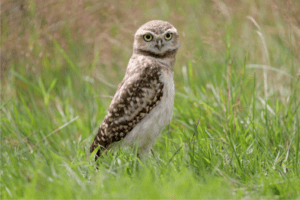
Burrowing Owl Bird Facts
- Common Name: Burrowing Owl, Shoco
- Scientific Name: Athene cunicularia
- Scientific Family: Strigidae
- Life Span: 6-8 years
- Size: 7.5 to 9.8 inches
- Wingspan: 20.0 to 24.0 inches
- Weight: 4.5 to 9.0 ounces
- Conservation status: Least Concern
How To Identify A Burrowing Owl
Some major identifiers of burrowing owls are their yellow eyes, the white coloration on their eyebrows and throats, and their brown speckled with white mottled feathers. They also have long legs, no ear tufts, and they weigh roughly 6 ounces and stand 10 inches.
Differences Between Male & Female
There really aren’t any major differences between male and female burrowing owls. They are both 10 inches tall and both average 6 ounces in weight. They both typically have 22-24 inch wingspans as well.
Differences In Summer Plumage vs Winter Plumage
There aren’t too many differences between Summer and Winter plumage of burrowing owls. But for the males of the species, their coloration becomes paler and duller between March and August. This happens because their plumage becomes bleached from the sun.
Females tend to remain in the nest during the season, so they do not experience the same level of bleaching as their male partners.
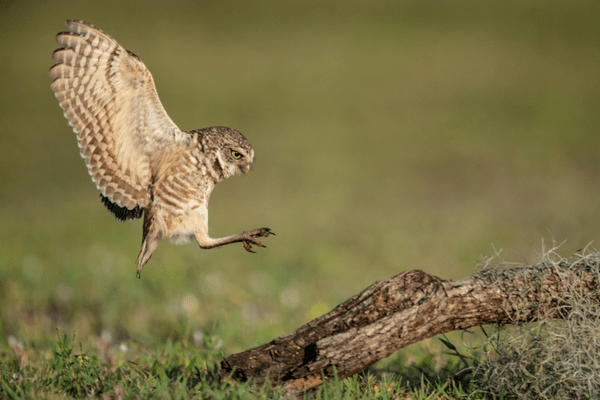
Where You’ll See Burrowing Owls
In Florida, it’s easy to find burrowing owls on the open prairies that are in plentiful supply in this state. You’ll find them in pastures, on golf courses, in airports, and in agricultural fields and they even make their homes in vacant lots. Drained wetlands even end up becoming important habitats for burrowing owls.
Burrowing Owl Migration Patterns
The interesting thing about burrowing owls is that they are mainly found in the western portion of the United States. But they also like the warm weather so they make a permanent home in Florida as well.
They live in other places besides the United States. You can find them in Canada at certain points of the year, in Mexico, the Caribbean, and Central America as well.
Diet and Feeding Preferences
Like most owls, Florida and Western burrowing owls prefer eating prey as opposed to birdseed and other types of bird feed. They’ll regularly hunt and eat reptiles, mammals, amphibians, other birds, and insects. Their diet is very dependent on specific seasons and the availability of food.
These owls tend to remain most active between dawn and dusk. But on occasion, they will hunt at night or during the day when the situation warrants it. If they are hunting mammals, as an example, this will typically take place at night. On the other hand, when they are hunting insects, as another example, they hunt and gather them during the day.
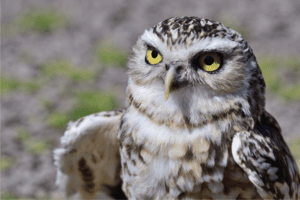
Burrowing Owl Nesting Facts
- Clutch Size: 2-12 eggs
- # of Broods: 1 brood, sometimes 2 broods in Florida
- Incubation Period: 28-30 days
- Nestling period: 44-53 days
- Egg Description: White and smooth
For the most part, the nest of a burrowing owl is several yards long. It is also roughly 3 feet deep, but the size is dependent on the previous animal that excavated the hole in the first place.
Their burrows often take a plethora of different turns and twists. The entrance to their borough is typically 4-6 intros wide and located within a mound of dirt.
When these owls borough, they like to bring materials with them including grass, feathers, and livestock manure.
And on the occasions when these owls actually dig their own borough, it usually takes several days. That’s why they tend to find and use an existing borough because the preparation process is a lot faster.
Burrowing Owl Behavior
Burrowing owls are hunters that like to stay close to the ground. When chasing prey, they will run, walk, fly, or hover while using their talons to seize their target.
These birds are known to sleep on dirt mounds at the entrance to their burrows. Either that or they will go to sleep in depressions in the ground.
Typically, this bird remains monogamous for the most part and when they breed, they tend to stay and lose colonies that are relatively close together.
The female burrowing owl will remain inside or near the nest until her chicks fledge. Males, on the other hand, will remain near the borough at the entrance or on a nearby perch in order to stand guard and defend the home when necessary.
How do the male burrowing owls defend their homes? They do so by displaying a weaving crouch of fluffed feathers, or by vocalizing, or outright attacking or chasing potential threats using outstretched talons.
Pairs of male and female burrowing owls will rub bills, preen, vocalize together, and perform other activities together. The male hunts and gathers food for the female and the young fledglings.
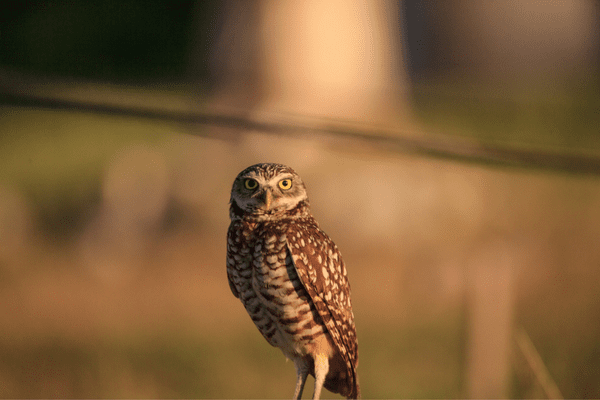
Tips for Birdwatchers On How To Attract Burrowing Owls
Unlike other owls that perch in trees or borough in nesting boxes or hollows in trees above the ground, the burrowing owl makes its home underneath the floor.
The best way to attract a burrowing owl is to create a starter borough for them. It’s easy to do and it only requires three small steps. They include:
- Begin starting the entrance by digging a deep hole that is 8-12 inches deep. Do this by using a hand trowel or a small shovel. Make sure the hole is dug at a 45° angle.
- Next, use the dirt that you’ve dug out of the hole and pile it outside the hole. Male burrowing owls often sleep on the dirt pile.
- To get the attention of male and female burrowing owls, take a wooden T-perch and install it right next to the new burrow.
This should more than suffice to attract these gorgeous owls to your backyard.
Conservation Status
The burrowing owl is still quite numerous as far as its population is concerned, so it’s considered a Least Concern species. Nevertheless, in Canada between 1966-2019, their overall population declined by 3.5% per year. In the United States during the same period, their population has declined by just over 4% per year.
In particular, the population of burrowing owls has declined the most in the United States and coastal California, the Midwest, Florida, and North and South Dakota.
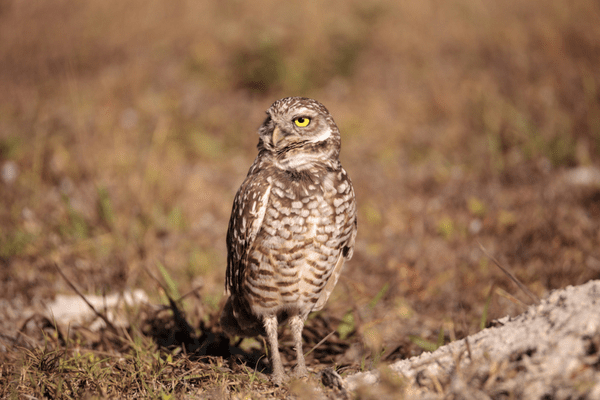
Fun & Interesting Facts
- Out of every small owl species, the burrowing owl is the only one to perch on the ground. Instead of flying away, they tend to flatten themselves or run if their area is disturbed.
- While remaining in the nest, the burrowing owlet will make a cry of distress that actually sounds like a rattlesnake. This comes in very handy to scare other predators away.
- The burrowing owl is actually one of the smallest owl species in existence. It typically weighs between 4-7 ounces.
- This owl looks very different from the great horned owl because it doesn’t have any ear tufts.
- An interesting fact is the eyebrows of the burrowing owl are long and white. Their eyebrow hours tend to run across their entire face.
- More often than not, other creatures will build burrows for burrowing owls. They will take over abandoned those typically created by squirrels, badgers, prairie dogs, and the occasional tortoise too.
- In an effort to attract insects, the burrowing owl will line the burrow with manure. As we all know, flies and other insects are very attracted to the scent of manure.
- Since this creature spends much of its time underneath the ground, which certainly lacks fresh air flow, they’ve developed carbon monoxide resistance at a much higher level than other species. This makes it possible to survive in places that don’t get too much fresh oxygen.
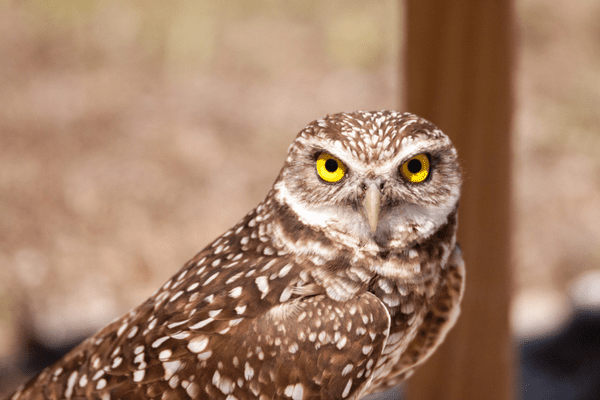
Explore More Species in This Family
- Long-Eared Owl
- Eastern Screech-Owl
- Elf Owl
- Flammulated Owl
- Snowy Owl
- Barred Owl
- Western Screech-Owl
- Northern Saw-Whet Owl
- Northern Pygmy-Owl
- Spotted Owl
- Short-Eared Owl
- Boreal Owl
- Great Gray Owl
- Northern Hawk Owl
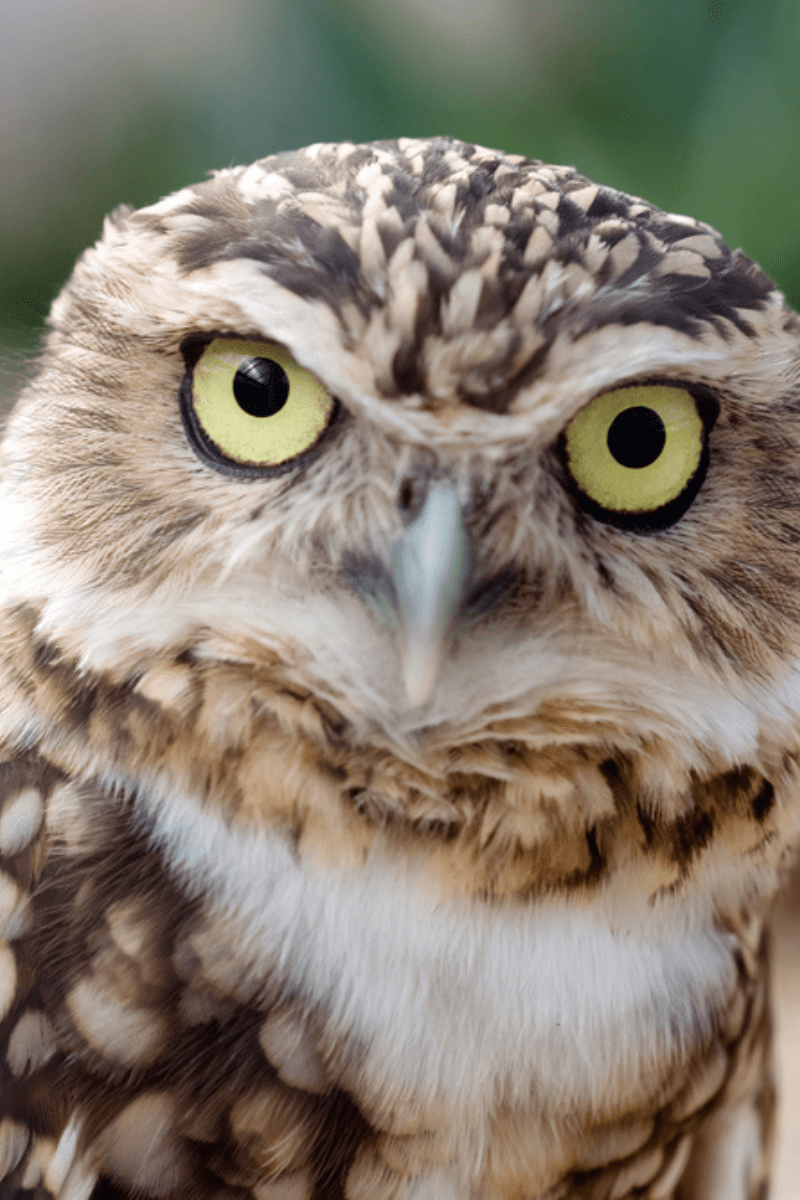
from BirdInformer.com https://ift.tt/Cs4y7Ia

No comments:
Post a Comment